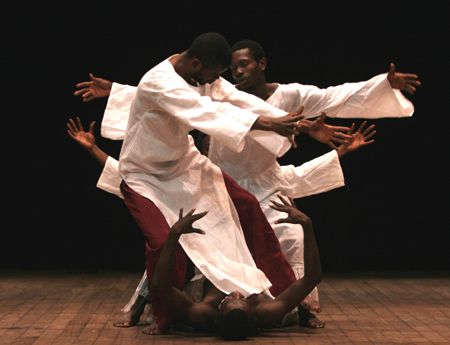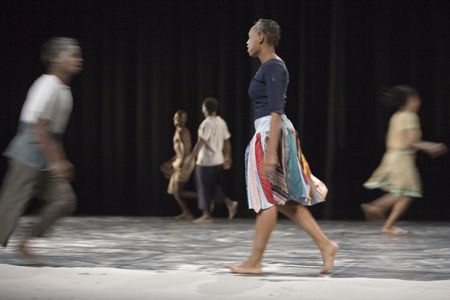Dance
Danse en Créations 6 - the prize-winners
Danse l'Afrique, Danse!
German premiere

The choreography competition Danse en Créations is the most important platform for contemporary African dance and a mirror of recent developments in Africa. Prize-winners so far have included important dancers such as Seydou Boro with his company Salia nï Seydou. This time, IN TRANSIT is presenting a German première, and the first stage of a world tour: the three winners of the 6th Biennale of Dance, hold for the first time in Paris at the end of April.
In 2006, eleven young companies, selected from among ninety-eight contenders, presented their productions in Danse en Créations. The following performers took part: Jean-Michel Fonkam Moukam - Phénix company, Cameroon; Panaibra Gabriel - Cultuarte, Mozambique; Musa Hlatshwayo - Mhayise Productions and Hlengiwe Lushaba - The company from South Africa; Tierema Lévy Koama - Sombo company, Burkina Faso; Lailah Masiga - Alama ya dance, Kenya; Abdel-Rhamane Mbang Bousso Hadji - Ballet Théatre Leila, Chad; Orchy Nzaba - Li-Sangha company, Congo Brazzaville; Andréya Ouamba - Premier temps company, Senegal; Maria-Helena Pinto - Choreographic Research Centre, Mozambique; and Abubakar Usman - Afrika Kreative Dance Company (AKDC), Nigeria.
These are the winners - performing at IN TRANSIT 06:
Panaibra Gabriel/Culturarte
Mozambique
"Dentro de mim outra ilha"
Orchy Nzaba/Li-Sangha company
Congo Brazzaville
"Mona-Mambu"
Andréya Ouamba/Premier temps company
Senegal
"Impro-Visé_2"
More information on the winning groups:
Panaibra Gabriel/Culturarte Mozambique
Tiny luminous beaches are cut out on the ground and dancers move from one to the other. Can we see them as small islands, as an echo to the name of the piece by Panaibra Gabriel: Dentro de mim outra ilha – (Another island inside myself?). Being clearly aware of the space that we occupy, but being able to change it and realising that others do the same thing: this is already a dance project.
The Mozambican choreographer quotes his compatriot, the poet Júlio Carrilho: “Each individual is like a small island occupying a certainterritory on Earth, my body is the islet where I preserve my culture, my culture is my spirit, my memory and my beliefs… there is a narrow and fragile bridge between you and myself which links me to yours”. There will be clear aquatic references in this piece. Could we see the world as a bath and think of the body as the “holder, even more than the spirit, of vast knowledge about the mechanisms of action, reaction and interaction with outside powers”?
The five performers of Dentro de mim outra ilha seem to test the relationship between the individual and group, and enclose this issue in the bigger query about the relationship between a being-body – where responsibility and culture are located – and the world. At the beginning, each performer is strictly isolated in a specific action: one skilfully pinches his cheeks, while another anchors a mechanical arm and leg to his chest, and a third man wants to take hold of his own back. The first unison will take time to show up. And it will be incredibly brief, as if to better highlight, straight away and by contrast, a new solo action breaking away from it.
Thus, the composition rejects geometrical symmetry. There are multiple trajectories, like loose, intertwined combinations. The actions are just as multiple and varied, becoming increasingly intense. But all this remains clear, as the basic issue has been delimited. It is through a chosen, reciprocal dynamism that the whole is systematically refuted by the individual. This dynamism grows by constantly rebounding, without being weighed down, whirling and spirited, slipping between approaching and ducking away, over live or recorded music by clear percussion, violin and piano which is itself spirited.
There is a fluctuating and productive way of weaving links with others. With the world.
Panaibra GABRIEL lives and works in Maputo, the capital of Mozambique. He started off as a traditional dancer in 1993, but then switched to modern dance. Abroad, his approach linked up with the initiatives of Danças na Cidade (Lisbon), often alongside choreographers carrying out advanced research. In France, he choreographed a solo performance for Sandra Martinez in the context of “Vif du sujet” programmed by the SACD in Montpellier (“Danse 05”). He leads a training programme in Mozambique in close cooperation with artists from Madagascar (Ariry Andriamoratsiresy) and South Africa (Boyzie Cekwana).
Culturarte was founded in 1998 by Panaibra Gabriel. As well as its productions, this company is also developing a workshop programme and runs a six-month vocational training course,designed, notably, in partnership with P.A.R.T.S.
Orchy Nzaba/Li-Sangha company Congo Brazzaville
One of the traps in which we confine African dance is to allow it to be torn apart between tradition and modernity, by suggesting that the former mainly stems from inertia while the latter is a result of progress. The Congolese choreographer, Orchy Nzaba, is not prepared to accept that. He named his piece Mona-Mambu. It is a Kongo expression describing the ability to see and approach the realities of life with clearsightedness. And what do these realities tell us: that the Kongo people have always known how to retranscribe their daily life through proverbial scenes and original body movements. We fail to see when it could ever have been fixed in unchanging forms.
In fact, Mona-Mambu is a piece in constant movement whose impact is enhanced by its cast of five boys. One of them starts on his own and commits himself to it with a firm step, treading backwards and forwards with arms windmilling overhead, like a furious animal. Chest first, rhythms cut by clear breaks between slow and fast sequences, great spiralled spins: this boisterous dance is not scared of itself.
Then, the piece is built up with numerous sequences set end to end. The next one sees the dance’s guide giving vigorous gestured commands in a firm voice. Unisons follow unisons, with few transitions, rebounding spectacularly. The body moves with very balanced steps, clear segmentations, separate jumps and heavy stamps. So what sets this Congolese company apart, as a quick glimpse of this dance might give the impression of something “typically African” (if that concept exists)? What is truly specific is the continual shift between the grand dance sequences and situations from daily life which are sometimes almost trivial, as if these two levels have become impregnated with each other, without a warning.
There are impressive forward dives. The next moment sees the same dancers methodically rubbing each other. There are high, whipped jumps, then legs are flung across the legs of the others. An unusual embrace ends in bursts of laughter. They shake hands, two by two, but it is only the prelude for recomposition of a grand geometrical scene.
Thus, the whole group seems to be a flexible, expanding material and many barriers, mental one at least, also start to shift.
Orchy NZABA is in charge of the choreographic workshop at the French Cultural Centre in Brazzaville (Congo). He trained with the Paco Decina, Choream and Julie Dossavi companies, as well as at the Ecole des sables in Senegal. He is a distinguished performer of both music and dance.
The Li-Sangha company has just been founded.
Andréya Ouamba/Premier temps company Senegal
There is an unwritten rule in African dance shows: the sequences in unison are moments when the energy is increased, conveying emotion and involving the audience. The opposite happens for the Impro-Visé_2 duo.When a (rare) sequence in unison occurs, it is a very quiet, restrained and suspended moment. We understand this after the choreographer, Andréya Ouamba, explains in very few words that he unusually intends to: “create a link between nothing and space or sight”.
Can a choreography take “nothing” into account ? Indeed it can. We too often consider that dance needs to justify itself, to tell stories, to announce itself through meanings. Impro-Visé_2 states and practises the opposite: nothing else happens but what is happening between the choreographer, himself a performer, and his partner Fatou Cissé. Nothing more than an intense moment of dance, a space captured by the existence of sharing between two artists who are far more interested in what is being created between them and beyond them, than in each other.
Initially, each dancer is stuck in a case, into which crumpled newspapers have been crammed, then taken out and spread around. They both get out and go on their way.
She is resolute, clear and sound. With steps like a wading bird, her aquiline body flung out tightly to the cardinal points, she runs behind her own forward-leaning torso, swept away to roam horizontally, as if astonished at herself. He is more feline, chuckling discreetly. He stands firmly with his legs apart, swinging his torso in semi-circles like a reaper, then seizing it with what seems like suspended abandon, under gazes burned from the inside.
This dance is like a dream experienced every night. It yields weird grips; she sits astride the calf which he holds out behind him or secures his neck by gripping it in a single bound. There is relational teasing in these moments, and figures appear as if produced by a skilfully disrupted mechanism. We shall never know what the voluble dancer says, while gabbling in an unidentified language, as if mocking, while her partner performs a solo of twisted sculptures and self-inflicted knocks, dry and panting, flockering discreetly.
Here, dance knows how to be in a different world.
Andréya OUAMBA, born in Pointe-Noire (Congo Brazzaville), lives and works in Dakar (Senegal). He practised street hip-hop, Afro-Modern dancing and was trained at the Ecole des sables.
The Premier Temps company was founded in 2000 by Andréya Ouamba. Fatou Cissé, who appears in Impro-Visé_2, is continuing her own career as a performer and is attracting considerable attention. She was particularly outstanding in the Picc solo performance, choreographed by Gacirah Ndiagne (2003).


